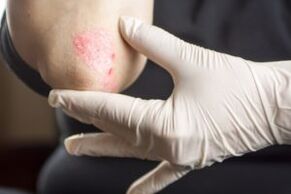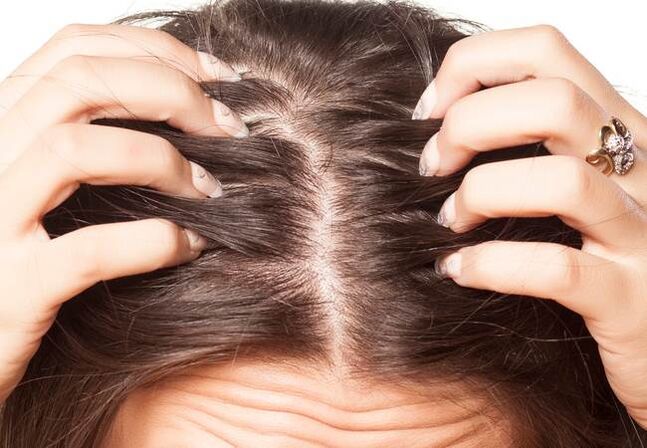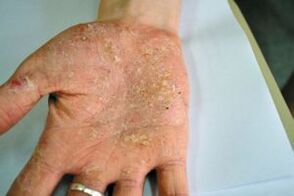First of all, it is worth finding out what psoriasis is and what causes of this disease.Psoriasis is a chronic non-infectious skin disease, which is characterized by the rash of red-yellow knots and stains with a peeling area on the body.Most of the time, psoriasis is recorded in young people between the ages of 18 and 45, but there are cases of psoriasis in children and the elderly.The essence of the disease is that for the unknown reason, the cells of the epidermis begin to share accelerated, to form the skin thickening and further growth under these places in the capillaries.

This disease does not accompany humanity for a hundred years and possibly from the moment of its appearance.Researchers find the remains of mummified old people who were sick on psoriasis.In the Middle Ages, this disease was often confused with leprosy and only in the middle of the XIX century.Psoriasis was defined as a separate illness - from this moment the scientific examination of the disease began.Surprisingly, scientists cannot completely find out the cause of the disease.Several theories were brought up on this occasion:
- Inheritance.The cause of the disease is inherited in the immune system.So if one of the parents of psoriasis is sick, the likelihood of illness in a child is about 20%.If both parents have an illness, the likelihood of psoriasis in a child increases to 80%.Scientists find that the disease itself is not inherited, but only a predisposition to their occurrence.
- Virus theory.The justification that the cause of psoriasis can be a virus to find many scientists.The confirmation of this theory has not been found at the moment.Other infectious diseases - flu, almond inflammation, acute respiratory viral infections can influence the course of the disease, which leads to worsening or a trigger for the first external manifestations of psoriasis.
- Immunt theory.The justified and generally recognized version of the appearance of psoriasis.The conclusion is that the cause of the disease is a violation of the cellular connection of immunity.More and more scientists tend to ensure that the disease is autoimmun - that is, the defense of the body turns against itself and begins to reject the skin cells and recognize them as foreign.
- Exchange theory.In order to find out the causes of the pathology, scientists carried out numerous examinations of patients with psoriasis.During this process it was found that all of them have violations of the metabolism.Especially low body temperature;Increased blood cholesterol;Distinctive balance of the vitamins.All of this leads to the conclusion that disorders in the exchange process play an important role in the occurrence of the disease.

Factors that cause the development of psoriasis
The fact that there are some triggers that cause the disease or provoke exacerbation are known from both patients themselves and doctors.Such reasons include:
- Stress, nervous overflow, psychological trauma;
- Hormonal violations;
- Taking certain medication: antibiotics, B vitamins, anti -inflammatory medication;
- Mechanical skin injuries: cuts, burns, deep scratches;
- Infectious diseases: tonsillitis, medium -ear inflammation media, sinusitis and infections caused by streptococcus - scarlet fever, erysipelas, etc.;
- Drink alcohol, not with the regime, malnutrition, smoking;
- A sharp change in the climate, long -term stay in the sun.
Symptoms of psoriasis
How can you recognize signs of an insidious disease and prevent it from spreading?The course of psoriasis is cyclical: the relief periods are replaced by remission periods.The disease has different forms, each of them has its own characteristic characteristic features, but there are general symptoms, the entirety of which clearly shows the presence of psoriasis in the patient.This is the so -called psoriasis triad:
- The phenomenon of stearin drops.If you scatter the surface of a psoriatic plaque with a fingernail, keratized skin scales, similar to drops from frozen stars, are separated from it.
- Under the separate layer of keratized particles there is a red shiny thin film.
- "Bloody Dew."If you scrap this film with a fingernail, small drops of blood will appear.The fact is that there are capillaries with thin walls and there are several points bleeding from the slightest physical effect.

All of these symptoms are accompanied by itching in the affected area.The first psoriative plaques are most common in places such as knees, elbows, groin business, scalp and armpits.First, the rashes are single, but when the disease develops, their number increases and plaques can merge together and influence the increasing surface of the body.Kebner syndrome also occurs - the appearance of new rashes in skin irritation.
Vulgar or ordinary psoriasis
One of the most common forms of the disease is 80% of patients with psoriasis, precisely by psoriasis vulgaris.The most characteristic feature is the appearance on the body of reddish papules - nodules with a rounded shape, clearly defined limits and slightly over the skin.The spots are covered with a gray robbery from the separate scales.Rashes can affect both individual parts of the body and spread on the skin, mainly in the skin folds, joints of the joints, places more often contact and skin stimulation of clothing.
Psoriasis of the scalp
In this form of the disease, mainly part of the head, covered with hair, but with another course of the disease, plaques can spread to the face, ears and neck area.Since it is quite difficult to see what happens on the head independently of each other, often in the initial phase of hair psoriasis, confuse them with ordinary dandruff and do not combine the symptoms.What are the signs of them to alert:
- Dry scalp;
- Serious itching;
- Pain and burning in the affected area;
- The appearance of the peeling similar to scales;
- Hair loss.
Psoriasis of nails
Psoriasis onichestrophy or nail psoriasis can manifest themselves as an independent disease and is a complication of ordinary psoriasis.External signs of the disease are very similar to a fungal infection.The nail plate thickens, its color changes - it can vary from yellowish to gray.The bare eyes are visible traces of underlining bleeding - red or purple stains.There is an oil spot syndrome - a yellowish spot under the nail plate.The nail itself is flattened, it falls rough in the middle, in the middle there are pressed traces.Small holes also appear - as from injections with a needle, the surface resembles a thimble.The process of accumulation of dead cells begins under the nail bed.In the future, this can lead to a replacement of the nail and loss.Both nails on the fingers of both hands or only a few can be affected.

Pustulies psoriasis
It differs from the usual when the lesion is characterized by the occurrence of redness and pustules - bubbles with purulent content.With the further development of the disease, the bubbles peel off and release the erosion surface.Pustular psoriasis has a more difficult course, can be complicated by the connection of secondary infection and poisoning of the body until death.
Genital psoriasis
A fairly rare form of the disease.It is characterized by the appearance of small, waste -drawn plaques up to 1 centimeter in diameter.Favorite places: limbs and body.The appearance of rashes is accompanied by severe itching, often this is preceded by the transferred streptococcal infection.
Ladomarly needs of psoriasis
It is diagnosed in 15% of all patients with psoriasis.This shape is characterized by the appearance of papules on the palms and soles of the feet.In the affected areas there is severe itching and warmth, often the skin tears and bleeding.Patients have severe difficulties when walking, the inability to carry out actions with their hands.The pustular type of Palmar psoriasis is characterized by the appearance of redness and blisters with liquid content on the skin.
Exudation psoriasis
This type of illness is characterized by the formation of crying plaques with uneven edges that are covered with numerous layers of a gray -haired crust.Such crusts are formed from the impregnation of keratized particles by exudate.If you try to remove it, the plaque can buy a reddish color, can bleed.This form is often found in patients, in whose history there are problems in the work of the endocrine system, metabolic disorders and diabetes mellitus.
Psoriasis arthritis

It is characterized by a number of symptoms of psoriasis and arthritis.Patients have joint pain that is limited in their mobility.The fingers swell heavily, the skin around them gets a bluish tint.In addition, the disease can influence the spine and sacrum.In addition to joints, tendons and cartilage together also suffer.
Diagnosis of psoriasis
As with the treatment of another disease, it is the main thing to find out the enemy of person and to start comprehensive treatment as soon as possible.The first thing you should do if you suspect the presence of psoriasis is to contact a dermatologist.The doctor will carry out a visual examination, make a scratch from the affected area and prescribe the tests:
- General blood test;
- General urine analysis;
- Calais analysis for eggs Golist.
- Blood sample
- Urine analysis
- Calais analysis
Sometimes these measures may not be sufficient for a precise diagnosis, since the symptoms of psoriasis can be lubricated.In this case, a biopsy is prescribed to distinguish psoriasis from other similar skin diseases, and separates a piece of tissue and a subsequent histological examination in the laboratory.In addition, the doctor collects information about the clinical manifestations, symptoms of the patient as well as the image of his life, the presence of bad habits and hereditary disposition for the disease.
Treatment of psoriasis
Unfortunately, it is impossible to get rid of psoriasis completely.However, this does not mean that you simply cannot pay attention to the presence of this diagnosis.Subject to all the recommendations required by the prospective doctor, you can achieve a lasting long remission and live for years without remembering that you are sick of psoriasis.There is no universal treatment methodology because it depends on factors, such as:B.:

- Age of the patient;
- Type of psoriasis;
- The size of the affected areas and the location of its location;
- The severity of the disease.
As a rule, the treatment of psoriasis is a number of measures that aim to eliminate and alleviate the symptoms of the disease, maintain the strength of the body and to eliminate the cause that caused the deterioration of the disease.
Pharmaceutical therapy
The rest of the disease must have to fight the disease.Therefore, the following treatment technology was developed for patients with a diagnosis of psoriasis: First, the medicines with the lowest number of side effects are prescribed.If the therapy does not have the right effect, the medication becomes more effective.But even a well -selected course of medication needs to be changed from time to time.This is necessary so that the body is not used to a certain medication and the effect of its action does not come to.The treatment includes medication and local ointments.The following medication are prescribed:
- Antihistamines - relieve itching, make it possible to sleep peacefully at night;
- Retinoids - derivatives of vitamin A - have a positive effect on the skin condition;
- Enterosorbts - their goal is to clean the body of the toxins;
- Hepatoprotectors - have a protective and restoration effect for liver cells;
- Enzyme help The gastrointestinal tract deals with the load;
- Non -steroid medication - alleviate inflammation and pain;
- Antibiotics - are required in cases in which the course of the disease is complicated by the connection of the infection.
- Cytostatics - reduce the pathological increased cell division increased;
- Immunosuppressors;
- Biological products.

In the early stages of psoriasis, unpleasant symptoms can remove different ointments and creams, which are also an obligatory component of a measure of the treatment of advanced disease cases.These funds can be divided into two large groups: non -hormonal and hormone -containing.
Physiotherapy
- A few decades ago, the positive effect of UV rays on the skin affected by psoriasis was proven.Today this method is successfully used in the treatment of the disease.O The radiation is carried out with special installations, and both the entire body and only individual areas can be exposed.
- Patients with psoriasis often suffer from depressive diseases that are associated with experiences with the disease.In this case, electron can help.The process has a calming effect, the patient relaxes, his psychological condition is stabilized.All of this has a positive effect on the course of the disease.
- The magnetotherapy helps to improve blood circulation, reduce itching, to normalize the metabolism.
- The method of cryotherapy or cold treatment has also proven its effectiveness in the treatment of psoriasis.The affected areas are exposed to steam from liquid nitrogen, with the itching decreasing, active metabolic processes are started in the skin cells.
- The treatment of resort system can have a very advantageous effect and promote the patient who enters the remission stage.
If you have diagnosed psoriasis, try not to get into despair.Medicine does not stand still and every year there seem to be more and more advanced medication that enable them to get rid of the symptoms of the disease for a long time.Follow all the recommendations of the doctor, list a healthy lifestyle and avoid factors that can provoke a deterioration as far as possible.

























